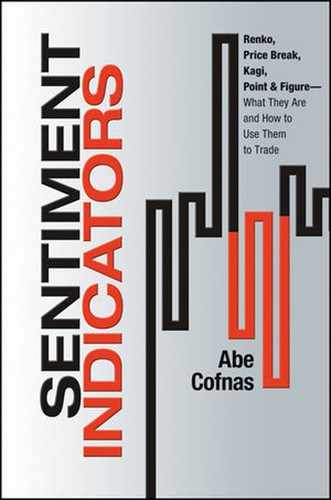Book Description
Praise forSentiment Indicators - Renko, Price Break, Kagi, Point & Figure: What They Are and How to Use Them to Trade
"By marrying technical analysis and market sentiment, Abe Cofnas takes the art of interpreting the markets' topological patterns to a new level. Sentiment Indicators shows us why shapes count."
—Steve H. Hanke, Professor of Applied Economics, Johns Hopkins University
"The process of extracting alpha in today's markets grows increasingly challenging as strategies become more automated, technology becomes more robust, and the market as a whole becomes more dynamic. Abe Cofnas's ability to quantify market sentiment gives traders an effective means to compete in this new paradigm. Sentiment Indicators provides one-of-a-kind insight into the world of proprietary trading strategies and serves as a solid framework for those professionals looking to further enhance their current trading protocols, as well as those seeking viable inputs in the programming of black box and algorithmic trading models."
—John Netto, President, M3 Capital, and author of Spread Trading EurexEquity Index Futures: A Guide for Traders
"Abe Cofnas does a great job in delivering how traders can profit from the proper use of Sentiment Indicators. This book is a must for all traders. I highly recommend it!"
—John Person, founder, NationalFutures.com
"Maybe you're already using technical and fundamental analysis to guide your portfolios. But if you're not also looking at sentiment indicators, then you're missing out. Sentiment indicators provide you with improved skills in filtering the noise of the market. And Abe Cofnas's book is a must-have manual for anyone working to grow their market knowledge and individual wealth."
—Addison Wiggin, three-time New York Times bestselling author; Executive Producer, I.O.U.S.A.; and Executive Publisher, Agora Financial
Table of Contents
- Copyright
- Acknowledgments
- Introduction
- 1. The Geometry of Emotions and Price Action
- 2. Price Break Charts: Key Concepts
- 3. General Trading Strategies for Applying Price Break Charts
- 3.1. Trading in the Direction of the Trend after a Counterreversal Block
- 3.2. Join the Trend after the Appearance of the First or Second Reversal Block
- 3.3. Fibonacci Resistance Confirmation
- 3.4. Countertrend Scalper
- 3.5. Always-In Strategy
- 3.6. Flip-Flop Reversal Entry
- 3.7. Momentum Trading—Six-Line Break
- 3.8. Price Break and Volume Data for Equity Charts
- 3.9. Multiple Setting Intervals and Price Break Charts
- 4. Applying Price Break Charts to Markets and Data
- 5. Channel Patterns, Cycles, and Price Breaks
- 6. Multiple Market Applications of Price Break Charts
- 6.1. Contemporaneous Visual Correlation of Instruments
- 6.2. Volatility and Price Break Charts
- 6.3. Price Break Charts and Sentiment Data: Innovative Applications
- 6.4. Price Break Charts and the Global Financial Crises
- 6.4.1. The Bloomberg United States Financial Conditions Index
- 6.4.2. Senior Loan Officers Survey
- 6.4.3. Philadelphia Federal Reserve Bank Business Outlook Survey
- 6.4.4. The Milwaukee Purchasers Manufacturing Index
- 6.4.5. German Business Expectations
- 6.4.6. Japan Tankan Survey of Business Conditions
- 6.4.7. Commodity Markets and Price Break Charts
- 7. Price Break Charts and Option Trading
- 8. Renko Charts Revived: The Microdetection of Sentiment
- 8.1. What is Renko Charting?
- 8.2. Tactical Trading Rules for Renko Charts
- 8.3. Key Components of a Renko Charts Trade
- 8.4. Step 1: Renko Chart Setting Sizes and Time Intervals
- 8.5. Step 2: Select Chart Time Interval: Use Three Time Intervals
- 8.6. Step 3: When a Trade Enters the Average Target of Profitability, Turn On the Renko Charts
- 8.7. Time and Bricks
- 8.8. Renko Charts and Economic Data Release Trading
- 8.9. Using Renko Charts to Enter Positions
- 8.10. Renko Charts in Multiple Markets
- 8.11. Renko Charts and Six-Line Break: Tools for the Scalper
- 8.12. Renko Bricks at the Tick Level
- 8.13. Renko and Volume
- 9. Kagi Charts: Waiting for the Turn of Sentiment
- 10. Point and Figure Charts
- 11. Integrating Price Break, Kagi, Renko, and Point and Figure Charting
- 12. New Directions in Sentiment Analysis: Charting Words
- 13. Beyond the Trend: Cycle Indicators Independent of Time
- Epilogue
- About the Author
